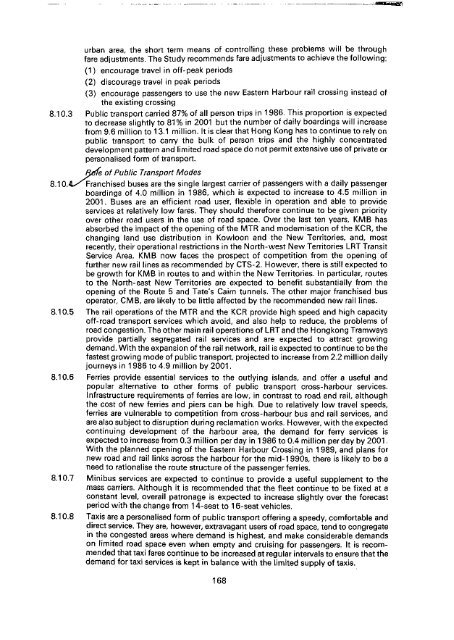Untitled - HKU Libraries - The University of Hong Kong
Untitled - HKU Libraries - The University of Hong Kong
Untitled - HKU Libraries - The University of Hong Kong
- No tags were found...
Create successful ePaper yourself
Turn your PDF publications into a flip-book with our unique Google optimized e-Paper software.
urban area, the short term means <strong>of</strong> controlling these problems will be throughfare adjustments. <strong>The</strong> Study recommends fare adjustments to achieve the following:(1) encourage travel in <strong>of</strong>f-peak periods(2) discourage travel in peak periods(3) encourage passengers to use the new Eastern Harbour rail crossing instead <strong>of</strong>the existing crossing8.10.3 Public transport carried 87% <strong>of</strong> all person trips in 1986. This proportion is expectedto decrease slightly to 81 % in 2001 but the number <strong>of</strong> daily boardings will increasefrom 9.6 million to 13.1 million. It is clear that <strong>Hong</strong> <strong>Kong</strong> has to continue to rely onpublic transport to carry the bulk <strong>of</strong> person trips and the highly concentrateddevelopment pattern and limited road space do not permit extensive use <strong>of</strong> private orpersonalised form <strong>of</strong> transport.Rdfe <strong>of</strong> Public Transport Modes8.10.4x x Franchised buses are the single largest carrier <strong>of</strong> passengers with a daily passengerboardings <strong>of</strong> 4.0 million in 1986, which is expected to increase to 4.5 million in2001. Buses are an efficient road user, flexible in operation and able to provideservices at relatively low fares. <strong>The</strong>y should therefore continue to be given priorityover other road users in the use <strong>of</strong> road space. Over the last ten years, KMB hasabsorbed the impact <strong>of</strong> the opening <strong>of</strong> the MTR and modernisation <strong>of</strong> the KCR, thechanging land use distribution in Kowloon and the New Territories, and, mostrecently, their operational restrictions in the North-west New Territories LRT TransitService Area. KMB now faces the prospect <strong>of</strong> competition from the opening <strong>of</strong>further new rail lines as recommended by CTS-2. However, there is still expected tobe growth for KMB in routes to and within the New Territories. In particular, routesto the North-east New Territories are expected to benefit substantially from theopening <strong>of</strong> the Route 5 and Tate's Cairn tunnels. <strong>The</strong> other major franchised busoperator, CMB, are likely to be little affected by the recommended new rail lines.8.10.5 <strong>The</strong> rail operations <strong>of</strong> the MTR and the KCR provide high speed and high capacity<strong>of</strong>f-road transport services which avoid, and also help to reduce, the problems <strong>of</strong>road congestion. <strong>The</strong> other main rail operations <strong>of</strong> LRT and the <strong>Hong</strong>kong Tramwaysprovide partially segregated rail services and are expected to attract growingdemand. With the expansion <strong>of</strong> the rail network, rail is expected to continue to be thefastest growing mode <strong>of</strong> public transport, projected to increase from 2.2 million dailyjourneys in 1986 to 4.9 million by 2001.8.10.6 Ferries provide essential services to the outlying islands, and <strong>of</strong>fer a useful andpopular alternative to other forms <strong>of</strong> public transport cross-harbour services.Infrastructure requirements <strong>of</strong> ferries are low, in contrast to road and rail, althoughthe cost <strong>of</strong> new ferries and piers can be high. Due to relatively low travel speeds,ferries are vulnerable to competition from cross-harbour bus and rail services, 'andare also subject to disruption during reclamation works. However, with the expectedcontinuing development <strong>of</strong> the harbour area, the demand for ferry services isexpected to increase from 0.3 million per'day in 1986 to 0.4 million per day by 2001.With the planned opening <strong>of</strong> the Eastern Harbour Crossing in 1989, and plans fornew road and rail links across the harbour for the mid-1990s, there is likely to be aneed to rationalise the route structure <strong>of</strong> the passenger ferries.8.10.7 Minibus services are expected to continue to provide a useful supplement to themass carriers. Although it is recommended that the fleet continue to be fixed at aconstant level, overall patronage is expected to increase slightly over the forecastperiod with the change from 14-seat to 16-seat vehicles.8.10.8 Taxis are a personalised form <strong>of</strong> public transport <strong>of</strong>fering a speedy, comfortable anddirect service. <strong>The</strong>y are, however, extravagant users <strong>of</strong> road space, tend to congregatein the congested areas where demand is highest, and make considerable demandson limited road space even when empty and cruising for passengers. It is recommendedthat taxi fares continue to be increased at regular intervals to ensure that thedemand for taxi services is kept in balance with the limited supply <strong>of</strong> taxis.168
















